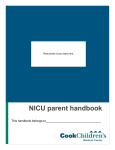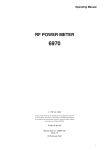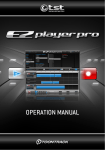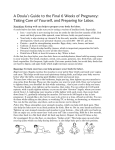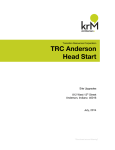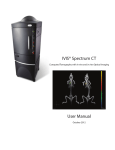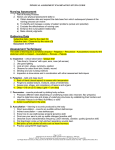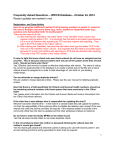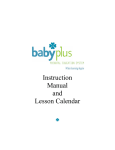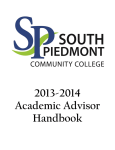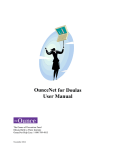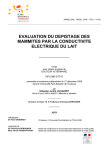Download Guidelines for WIC Agencies Providing Breast Pumps
Transcript
08-002 P O S I T I O N PA P E R National WIC Association Guidelines for WIC Agencies Providing Breast Pumps Introduction It is the position of the National WIC Association (NWA) that states should have a system in place to either provide a breast pump or help the breastfeeding mother to obtain one when needed. Although most mothers can initiate and maintain a milk supply without using a pump, for many women, having a breast pump can make the difference between breastfeeding and not breastfeeding. When mothers have effective breast pumps, they are more likely to continue breastfeeding, which can improve the health of the breastfeeding dyad and help the nation reach the Healthy People 2010 objectives for breastfeeding incidence, duration and exclusivity (see box) (1). The United States Department of Agriculture (USDA) notes “that breast pump usage greatly supports continuation as well as prolongs the duration of breastfeeding when mothers return to work and/or school” (2). Scientific evidence supports the fact that human infants grow and develop optimally when they are exclusively breastfed for the first six months and when breastfeeding continues thereafter with complementary feeding for as long as mother and baby mutually desire (3). Healthy People 2010 Objectives Increase the proportion of mothers who breastfeed their babies: Target In the early postpartum period: 75% At 6 months: 50% At 1 year: 25% Exclusively through 3 months: 40% Exclusively through 6 months: 17% The purpose of this paper is to provide guidance to assist state and local agencies of the Special Supplemental Nutrition Program for Women, Infants, and Children (WIC) in developing policies and procedures for providing breast pumps to WIC participants. The guidelines in this paper reflect USDA rules and represent state agency best practices. In 1989, Congress authorized states to purchase breast pumps with Nutrition Services Administration funds (4). In 1998, Congress authorized the use of WIC food funds to purchase breast pumps (5). The two funding options made it possible for all state agencies to provide breast pumps to participants. NWA 2001 S Street, NW Suite 580 Washington, DC 20009 ph. (202) 232-5492 fx. (202) 387-5281 www.nwica.org The following are some reasons for which breast pumps may be provided: (2, 6): 1. When infants are premature and unable to suck 2. When infants have severe feeding problems (i.e., cleft lip or palate); or unable to suck 3. When mothers have difficulty establishing or maintaining an adequate milk supply due to maternal/infant illness 4. When mothers and infants are separated (such as hospitalization or returning to work or school) 5. When mothers have temporary breastfeeding problems, such as engorgement 6. When mothers have twins or triplets In addition to breast pump support, mothers in these situations need lactation assessment, counseling, and support to reach their breastfeeding goals. Definitions Breastfeeding promotion - providing a prenatal participant with information and encouragement about breastfeeding to help her make the best feeding decision for her and her baby (7). Breastfeeding support - providing the assistance a mother needs to meet her breastfeeding goals. Providing breast pumps, for example, is an important component of breastfeeding support (7). Breast pump - any electrically or manually controlled device used to remove milk from a mother’s breast. Collection kit - the parts of a breast pump that touch the breasts and collect milk. Collection kits attach to an electric or pedal pump. They are intended for one user only. Manufacturers make collection kits specific to their brand of pumps. Most kits can also be used alone as manual pumps. A collection kit may be called a breast pump kit, pump attachment kit, personal kit, or accessory kit. Expression - the removal of milk from the breast either manually (by hand) or mechanically (with a pump). Hand expression - a technique to remove milk from the breast using only the mother’s hands. Hospital grade electric pump - a type of multi-user electric pump that has a motor that is sturdy, durable, and operates on a closed system that prevents the milk from reaching the motor. It is recommended for regular use by mothers who need to pump several times a day to initiate, increase, or maintain their milk supply long term. Manual pump - a breast pump powered by the user (usually through arm and hand movements); also called a hand pump. Manual pumps are intended for one user only. Multiple user electric pump - a breast pump designed for more than one user. It has a closed system that accepts single and double collection kits. The pressure on some models is regulated by the user while other models are fully automatic. The hospital grade electric pump is the most durable type of multiple user pump. Pedal pump - a breast pump with a piston that is powered by the user’s foot. It can be used with a single or double collection kit. This pump can be useful for mothers with compromised hand or arm movement or no access to electricity. Pedal pumps can be loaned to many users because there is no risk of cross-contamination since there is no motor. Single user pump - a breast pump designed and warranted for use by one mother. Single user pumps may be manual, electric, or battery-operated and may be fully automatic or semi-automatic. They may allow for single or double pumping. Some are for occasional or short-term use and others are for regular, long-term use. Implementing a Breast Pump Program States should develop appropriate policies and procedures for breast pump issuance, follow-up, and management. Policies should guard against fraud, abuse, and agency liability while encouraging assessment of a mother’s intention to provide milk for her infant. States should determine what types of pumps they will provide and for what reasons. States have the option of giving single user pumps to mothers or selling them at a nominal cost. States may also loan multi-user pumps or contract with a third party to provide pumps to participants (6) 2 State agencies should contact their state Medicaid programs to determine whether and under what circumstances Medicaid will provide pumps for medical necessity (6). It is not advisable for WIC agencies to issue used collection kits, even if sterilized. The cost of providing new collection kits is minimal when compared to the potential risks and liabilities of cross-contamination from reuse (6). Breast pumps should not be provided prenatally or as an inducement to consider or continue breastfeeding. Most mothers can establish and maintain lactation without using a breast pump. Pregnant and breastfeeding women should be given information on hand expression, which can meet the needs of some mothers to relieve engorgement or express milk for a later feeding. Women who are not planning to breastfeed may find hand expression useful to relieve discomfort when their milk comes in. Providing breast pumps to all breastfeeding women regardless of need may have the unintended consequence of reinforcing a lack of confidence to breastfeed (6). Before issuing a pump for a medical reason, WIC staff should determine if the mother could obtain a pump from the hospital or if she has coverage for a pump through private insurance or Medicaid. Policies for a breast pump program should: (6) Require a thorough evaluation of the mother and infant to determine the type of pump required Describe a triage system for distribution if need exceeds supply Establish criteria for issuance of each type of pump Establish procedures to ensure that the participant fully understands her rights and responsibilities when signing liability release forms Describe appropriate usage instructions and education for the participant Prohibit the distribution of breast pumps to a participant prenatally Describe required follow-up with a pump recipient after issuance to determine if the pump is operating correctly and if the mother is using it properly Encourage regular follow-up with the mother In addition, when deciding whether and which pump to provide, WIC staff should consider the age of the baby, number of hours of separation, frequency of separation, the predicted length of use, the amount of any supplemental formula given by the WIC Program, the reason for issuing the supplemental formula, and the mother’s breastfeeding goals. Staff Competencies Polices should describe the required knowledge and training of all staff. At a minimum, staff who do not issue and manage pumps should be aware of the pump program and basic procedures for referring participants for pump issuance. When developing a breast pump program, it is advised that designated trained staff implement and manage the program (6). The competencies of staff who issue pumps may include the ability to: Assess a mother’s need for a breast pump and select the appropriate pump for her need Answer participants’ questions Provide appropriate breastfeeding assistance, counseling, and follow-up services Teach a mother how to use, assemble, clean, and care for a pump Teach hand expression Develop a pumping plan with the mother Properly clean multi-user pumps upon return 3 Participant Education Policies for participant education should ensure that staff: Emphasize the importance of feeding the infant at the breast Teach hand expression Develop a plan with the mother for pumping (frequency, location, length of pumping sessions, etc.) Give the participant verbal and written instructions on the proper assembly, use, and cleaning of the pump Have the mother demonstrate the proper use of the pump and that she can assemble and disassemble it Give the participant verbal and written instructions on how to safely collect, store, warm, and feed human milk Instruct the mother on what to do if the pump breaks or does not work WIC health professionals can teach hand expression using breast models, diagrams, handouts, or videos. Purchasing Breast Pumps and Collection Kits WIC agencies should have manual and electric pumps available so that an appropriate pump may be provided based on participant need. Factors to consider when selecting a breast pump manufacturer or brand: Reputation for quality breast pump equipment Reputation for ethical marketing practices Adequate warranty coverage Availability of technical assistance Replacement or repair of defective products Company liability insurance Factors to consider when purchasing breast pumps and collection kits: Reasons for which pumps will be issued Expected frequency and duration of use Efficiency and effectiveness Cost and availability Ease of cleaning and assembly Kit parts can be sterilized Convenience and portability Availability of more than one flange size to accommodate different size breasts and nipples A gasket that does not come in contact with the milk Ease of obtaining replacement parts Printed instructions written at an appropriate literacy level that include helpful illustrations and cleaning methods, and are available in other languages 4 Features to consider when selecting electric pumps: (8) Suction variability easily controlled or adjusted by the user Pressure settings mimic that of an infant Safe levels of suction pressure and range for efficient pumping cycles Semiautomatic (mother controls suction) vs. automatic cycle range that simulates the pattern of a suckling infant Adaptability to single or double pumping Pump efficiency for adequate milk removal Durability Noise level Closed system to prevent milk from flowing back into the motor on multi-user pumps Insect-proof motor UL approved power cord and plug that fits a standard electrical outlet Availability of adapters that connect electric pumps to car power outlets Inventory Control To prevent loss and unauthorized distribution of pumps, trained staff should manage the inventory records, storage, distribution, and recovery of breast pumps. Components of inventory control include the following: Secure storage for all pumps and kits Standardized procedures for maintaining inventory logs Tracking logs on multi-user pumps that may include: Ô Serial numbers Ô WIC inventory tag numbers Ô dates received into inventory Ô pump location (in storage or in use) Ô information on the current user Ô date of issuance Ô reason for issuance Ô date pump is due for return Ô follow-up contacts and actual return date Ô current condition Ô maintenance history Permanently marking loaner pumps as “Property of the WIC Program” Procedures to recover loaned pumps that are not returned on time Written Agreements Written agreements between the WIC agency and pump recipient are strongly recommended for pump distribution programs. Policies should describe the use of written agreements and identify required components or provide a standard form or agreement, approved by legal counsel, which includes a release of liability and participant signature. This release provides protection to the WIC agency in the event of injury or cross-contamination due to improper use. The agreement should include language that documents participant training on the use and maintenance of the pump and the safe storage of human milk. Written agreements can be used to inform the mother that the pump is for her use only; that the collection kit must not be given or loaned to anyone else because of the risk of disease transmission; and that selling WIC pumps is illegal and will be investigated. 5 Documentation Provision of a pump to a participant should be documented in the participant's record. This facilitates communication with other WIC staff and protects the WIC agency from liability issues. Documentation includes progress notes and written agreements. Documentation may describe: The reason for issuing the pump The mother’s commitment to continue breastfeeding The type of pump provided An evaluation of the participant's understanding about using and cleaning the pump A summary of the counseling and education provided, including a written pumping plan Plans to follow-up with the participant Loaning Multi-User Breast Pumps Agencies that loan multi-user breast pumps should diligently protect the women who use the pumps and ensure that pumps are returned. When developing policies for loaning multi-user pumps, agencies should: (6) Require a written agreement between the Program and the participant Protect against loss or damage Describe procedures for retrieving multi-user pumps that are not returned Require follow-up within 24 hours after issuance to ensure proper pump operation and usage Require ongoing contact with the participant to evaluate continued need for the pump Monitor inventory through frequent audits Provide guidance for contracting with a third-party, such as a pump rental station, if that option is chosen WIC staff must ensure that the participant fully understands that she is responsible for the loaned pump and that she will be required to reimburse WIC for the full value of the pump if it is lost, stolen, or damaged. “Agencies may not terminate or suspend participants for unreimbursed loss or damage to loaned pumps. However, States may be able to recoup the value of a pump by imposing a financial penalty on participants who fail to return a loaned breast pump. To impose a penalty, a State or local agency would need a previously signed agreement clearly establishing the participant’s responsibility to return the pump undamaged or otherwise be subject to a financial penalty” (6). It is recommended that the participant read and initial each statement on the loan agreement. If the participant cannot read, the loan agreement should be read to her. Written agreements for loaned electric pumps should include the following participant responsibilities: To not share, loan, resell, or give away a collection kit or loaned pump that has been issued to her To immediately report any problems with the pump To contact the lending agency at specified intervals to report that the pump is still being used To return the pump as soon as she stops using it, even if that is before the date the pump is due back to WIC To return the pump in working order and in clean condition To return the pump within the specified time period or request an extension of the loan To reimburse the program for the value of a pump that is lost, damaged, or not returned A deposit may be collected before the pump is loaned and refunded to the participant upon return of the pump if it is in proper working condition (6). If an agency takes refundable deposits for loaned pumps, information about the deposit should be included in the written agreement. 6 When a multi-user pump is returned to the clinic, staff is advised to: Wear protective gloves when handling the pump Visually check the pump for signs of insect and rodent infestation and take immediate steps to control the infestation (see Oregon State WIC’s Recommended Procedure for Sanitizing Hospital Grade Electric Breast Pumps in the appendix) Check for the return of all the parts Assess the pump for damage, document the damage, and send the pump for repair as necessary Test the pump to ensure it is in good working order Return any deposit that was taken Clean the pump motor casing and carrying case with sanitizing solution according to manufacturer’s instructions Document pump cleaning and sanitation Contracting with Third Party Providers State or local WIC agencies may contract with third parties such as hospital pharmacies, durable medical goods providers, and private lactation consultants to provide multi-user pumps to qualified WIC participants. The third party must adhere to all WIC breast pump policies and procedures and follow-up requirements when providing services to WIC participants (6). Private practice lactation consultants contracted to provide clinical breastfeeding care to WIC participants are not considered WIC employees according to federal regulations. There may be a conflict if a contracted lactation consultant is also a pump provider. State and local agencies should have policies to ensure that WIC employees are not affiliated with the third party with which they are contracting. States that allow local agencies to contract with third parties should require the local agency to obtain State agency permission before initiating a contract. When contracting with a third party provider, federal, state, or local agency purchasing regulations must be followed. Advantages of third party contract: The liability for equipment loss or damage is transferred to the third party (6). The third party provider is responsible for cleaning and repairing returned pumps. The third party provider is responsible for the time and paper work involved in applying for Medicaid and/or health insurance reimbursement, where applicable. A third party provider who is a private practice lactation consultant may also provide instruction and follow-up services if the contract stipulates. Follow-Up Follow-up with Participants Pump recipients are more likely to succeed at breastfeeding when there is ongoing follow-up. Such follow-up helps WIC staff to: Determine that the pump is operating correctly and the mother is using it properly Assure compliance with the recommended pumping routine Provide timely care, education, and encouragement Ascertain the infant's health status Determine when a mother is no longer in need of the loaned pump so she can return it 7 The table below lists best practices for follow-up: IF… A pump is issued for medical reasons A pump is issued for frequent use due to separation for work or school A manual pump is issued for occasional use THEN… Make an initial contact within 24 hours Follow up by phone weekly Ensure regular face-to-face follow-up with a breastfeeding specialist and If the baby is not hospitalized, ensure baby’s weight is checked routinely at WIC or by a medical provider Ensure a referral to a peer counselor Make an initial contact within 24-72 hours Provide bi-weekly follow-up by phone and Ensure regular follow-up at the WIC office, as appropriate Make an initial contact within 24-72 hours Follow up at the next WIC appointment Clear documentation of follow-up contacts with pump recipients is essential for assuring quality provision of services and determining the need for further breastfeeding assistance. States may consider limiting WIC voucher issuance to one month at a time in certain circumstances to provide more opportunities for follow-up care and allow WIC staff to have better control of inventory for loaner pumps. Follow-up with Health Care Providers WIC staff should communicate with health care providers when an electric pump is issued to a high-risk mother-infant dyad and when there are ongoing medical concerns related to breastfeeding management or infant growth and development. Appropriate release forms should be completed before discussing participant health information with a medical provider. Conclusion Most women can establish and maintain lactation without using a breast pump. Providing breast pumps to women who need them can increase breastfeeding exclusivity and duration. To serve WIC participants requiring breast pumps in the most effective way, WIC agencies will find it invaluable to have well-designed and well managed breast pump programs. It is NWA’s hope that the guidelines and best practices shared in this document will assist state and local agencies in this effort. 8 References 1. U.S. Department of Health and Human Services (HHS). Healthy People 2010: Midcourse Review. More Information available at www.healthypeople.gov; accessed March 21, 2007. 2. United States Department of Agriculture SFP 99-145, Breast Pumps as a Food Cost; 1999. 3. American Academy of Pediatrics Section on Breastfeeding. Policy Statement: Breastfeeding and the Use of Human Milk. Pediatrics. 2005;115:496-506. 4. The Child Nutrition and WIC Reauthorization Act of 1989 (Public Law 101-147). 5. The William F. Goodling Child Nutrition Reauthorization Act of 1998 (Public Law 105-336). 6. United States Department of Agriculture. WIC Final Policy Memorandum: SFPD 95-18, Providing Breast Pumps to WIC Participants; 1995. 7. Auerbach K. Breastfeeding Promotion: Why It Doesn't Work. J Human Lact 1990:6(2)45-46. 8. Riordan J. Breastfeeding and Human Lactation. 3rd ed. Sudbury, MA: Jones and Bartlett Publishers, Inc.; 2005. Resources 1. International Lactation Consultant Association. Standards of Practice for International Board Certified Lactation Consultants. 3rd ed. Raleigh, NC: International Lactation Consultant Association; 2006. 2. Lawrence RA. Lawrence RM. Breastfeeding: A Guide for the Medical Profession. 6th ed. Philadelphia, PA: Elsevier Mosby, Inc.; 2005. 3. Mohrbacher N, Stock J, The Breastfeeding Answer Book, 3rd ed. Schaumburg, IL: La Leche League International; 2003. 4. Pediatric Nutrition Practice Group of the American Dietetic Association. Infant Feedings: Guidelines for Preparation of Formula and Breast Milk in Health Care Facilities. American Dietetic Association; 2003. 5. The Healthy Meals for Healthy Americans Act of 1994 (Public Law 103-448). 6. Human Milk Banking Association of North America. Best Practice for Expressing, Storing and Handling Human Milk in Hospitals, Homes and Child Care Settings. 2nd ed. Raleigh, NC: Human Milk Banking Association of North America; 2006. 7. Centers for Disease Control and Prevention breastfeeding website: http://www.cdc.gov/breastfeeding/. 8. U.S. Food and Drug Administration breast pump website: http://www.fda.gov/cdrh/breastpumps/. 9. The National Women’s Health Information Center, U.S. Department of Health and Human Services Office on Women’s Health website: http://www.4women.gov/breastfeeding/index.cfm?page=home. 9 Links to WIC State Agency Resources Arkansas: http://www.healthyarkansas.com/breastfeeding/pdf/pump_adh.pdf Breast pump guide for staff. California: http://www.wicworks.ca.gov/breastfeeding/BFResources.html Breastfeeding resources, information on how to organize, track, and supply a WIC pump loaner program. Forms and information for the local and state WIC clinic. Kansas: http://www.kdheks.gov/nws-wic/resources.htm Breast pump cleaning instructions, breast pump helpful hints (English and Spanish). Michigan: http://www.michigan.gov/mdch/0,1607,7-132-2942_4910_19205_21312-47730--,00.html Breast pump inventory forms. Minnesota: http://www.health.state.mn.us/divs/fh/wic/localagency/bf/index.html Forms on breast pump education and procedures for purchasing pumps. Texas: http://www.dshs.state.tx.us/wichd/bf/bfwicres.shtm WIC pump program and forms. Washington: http://www.metrokc.gov/health/breastfeeding/ Resources including a pump decision tree tool. 10 Appendix of Sample Forms and Policies and Procedures Examples of forms used by WIC agencies are included in the table below. These forms are reprinted with permission. Title State Breast Pump Questionnaire (English, Spanish and answer key) Colorado Breast Pump/Aid Release Form Colorado Screening Questions for Breast Pump Distribution Massachusetts Multi-User Electric Breast Pump Loan/Release Oklahoma WIC Medicaid Information and Policy Wyoming WIC Breast Pump Release Tennessee Recommended Procedure for Sanitizing Hospital Grade Electric Breast Pumps Oregon Procedures for Receiving a Breast Pump Shipment New Jersey How to Inventory Breast Pumps New Jersey Single User Breast Pump Inventory Log New Jersey Decision Tree for Issuing Portable Electric Breast Pumps Ohio 11 Decision Tree for Issuing Portable Electric Breast Pumps (Ohio WIC) Is mother returning to work or school? Teach mother how to hand express her milk and issue a manual pump or make referrals to local rental stations. No Yes Does mother have a well-established milk supply? Help mother identify best options for her situation. Help mother identify causes of her low supply; follow protocol on ways to increase supply. Refer for a hospital-grade pump until milk supply increases to meet additional needs. No Yes Yes Will mother be separated from her baby at work or school at least 4 hours in a given day? No Issue a manual breast pump and/or teach hand expression. Yes Does mother strongly desire to pump at work or school and give breast milk to her baby? Yes & No Counsel mother about commitment required to pump at work or school. Reassure her that she can do it. Help her find the best option for her situation. Yes Does mother have access to electrical power where she will be pumping? Yes Issue a portable electric breast pump! 12 No Discuss options for pumping, including using a Medela Pedal Pump * Call the State WIC Breastfeeding Coordinator if a pedal pump is required Breast Pump Questionnaire (Colorado) Name: ______________________________ Do you have a pump? ___ Yes ___ No Date: ______________ If yes, what kind?______________________ Please tell us more about your need for a breast pump. 1. I need a pump: □ To use a few times a week. I am with my baby most of the time. □ I am returning to work or school on ________________________(date). □ I am having breastfeeding problems or can’t nurse my baby. The problem I am having is ______________________________________________________ □ Other: ______________________________________________________________________ 2. How long do you plan to breastfeed? ________________________________________________ 3. When you are away from your baby, what do you plan to feed the baby? □ Breast milk only □ Formula only □ Both breast milk and formula 4. If you are returning to work or school, answer these questions: a. How old will your baby be when you return to work/school? _______ b. How many days a week will you be working /attending school? ______ c. How many hours will you be away from your baby each day? _______ 5. Will your work/school schedule allow for breaks every 3-4 hours? If yes, how long will your breaks be? Yes No Unsure 6. Will you have a private place with electricity to pump? Yes No Unsure 7. Does your family want you to continue to breastfeed? Yes No Unsure 8. Is your employer/school supportive of breastfeeding? Yes No Unsure 9. Is your childcare provider supportive of breastfeeding? Yes No Unsure Staff Use Only Recommendation for type of pump needed, if any. ___Manual ___Pedal ___Loaned electric ___Single-user electric Reason: ___________________________________ ___________________________________________ ___________________________________________ ___________________________________________ Staff signature:______________________________________________________________ #101 BreastPumpQuestionnaire 13 CO Cuestionario del Equipo Para Extraer Leche Materna Nombre: __________________________________ ¿Tiene Ud. este equipo? Si___ No___ Fecha:_______________ Por favor díganos más con respecto a su necesidad de obtener un equipo para extraer leche materna. 1. Necesito el equipo para: □ Usarlo algunas veces por semana. Estoy con mi bebé casi todo el tiempo. □ Voy a regresar a la escuela o al trabajo. □ Estoy teniendo dificultades dándole pecho, o simplemente no puedo alimentar a mi bebé. EL problema que estoy teniendo es el siguiente:______________________________________ □ Otro: ________________________________________________________________________ 2. ¿Por cuanto tiempo planea darle pecho a su bebé? ______________________________________ 3. Cuando usted no está cerca de su bebé ¿con que planea alimentarlo? □ Únicamente con leche materna □ Únicamente con fórmula □ Con leche materna y con fórmula 4. Si usted está regresando al trabajo o a la escuela, responda la siguientes preguntas: a. ¿Que edad tendrá su bebé cuando Ud. regrese al trabajo o a la escuela? _______ b. ¿Cuantos días a la semana estará Ud. trabajando o atendiendo a la escuela? ______ c. ¿Cuantas horas al día pasara Ud. lejos de su bebé cada día? _______ 5. ¿Su horario de trabajo o escuela le permitirá descansos cada 3 ó 4 horas? Si No En caso de que si, ¿de cuanto tiempo serán estos descansos? Si No No estoy segura No estoy segura 6. ¿Tendrá acceso a un lugar privado donde extraer leche? Si No No estoy segura 7. ¿Su familia quiere que Ud. siga dándole pecho al bebé? Si No No estoy segura 8. ¿Su trabajo o escuela apoya la alimentación con leche materna? Si No No estoy segura 9. ¿El proveedor de los cuidados de la salud de su bebé apoya la alimentación con leche materna? Si No No estoy segura Staff Use Only Recommendation for type of pump needed, if any. ___Manual ___Pedal ___Loaned electric ___Single-user electric Reason: ___________________________________ ___________________________________________ ___________________________________________ ___________________________________________ Staff signature:______________________________________________________________ 14 Staff use only Breast Pump Questionnaire/Key Name: __________________________________________________ Date: ____________________ Do you have a pump? If yes consider type/provide education Please tell us more about your need for a breast pump. 1. I need a pump: □ To use a few times a week. I am with my baby most of the time. Consider pedal pump. □ I am returning to work or school on _______ (date). Consider single-user or loaned electric pump. □ I am having breastfeeding problems or can’t nurse my baby. The problem I am having is___________________________Consider loaned or single-user electric pump □ Other: _______________________________________________________ 2. How long do you plan to breastfeed? (if at least one year, consider single-user pump) 3. When you are away from your baby, what do you plan to feed the baby? □ Breast milk only Consider single-user pump □ Formula only Inquire why a pump is being requested □ Both breast milk and formula Inquire when and why pump would be needed 4. If you are returning to work or school, answer these questions: (to receive a single-user pump the mother must be separated from the baby at least 6 consecutive hours a day at least twice a week) a. How old will your baby be when you return to work/school?_______ >4 wks (consider single-user; if <4 wks consider loaned electric for a month or more) b. How many days a week will you be working/attending school? _______ 2 days or more (if 1 day/wk, consider pedal pump) c. How many hours will you be away from your baby each day? _______ >6 hours (consider single-user if more than one day a week; or loaned electric or pedal if one day/wk) 5. Will your work/school schedule allow for breaks every 3-4 hours? Yes (electric pump) No (Ask how they expect to pump) Unsure (Have her look into it, offer to assist) If yes, how long will your breaks be? need a minimum of 20 min to prepare, pump and clean up) 6. Will you have a private place with electricity to pump? Yes (Consider electric pump) No (Ask where and how they expect to pump) Unsure (Have her look into it and consider preference of participant) 7. Does your family want you to continue to breastfeed? Yes (Identify supporters) No (Identify supporters and allies) Unsure (Identify supporters and allies) 8. Is your employer/school supportive of breastfeeding? Yes (good, offer participant to submit support letter and educational materials) No (offer participant to submit support letter and educational materials) Unsure (offer participant to submit support letter and educational materials) 9. Is your childcare provider supportive of breastfeeding? Yes (great!) No (offer educational materials, ask what they intend to do) Unsure (offer educational materials, ask what they intend to do) #99 - BreastPumpQuestionnaire_key 09.2006.doc 15 Colorado Breast Pump/Aid Release Form FOR WIC CLINIC USE ONLY Type of pump issued: Manual Type of aid issued: Breast shells Type of Issuance: Loan Reviewed with WIC participant: Pumping plans Breast pump/aid assembly Breast pump/aid use Breast pump/aid cleaning Issued by: Pedal SNS Given Electric Serial No.____________________ Collection kit Storage of breast milk Who to call for help Returning to work or schoo Follow-up date: Participant, read and sign below: ✓ I have been given the breast pump/aid marked above. ✓ The use of the pump/aid has been explained to me and I fully understand how to use it. ✓ For baby’s health, I understand that this pump/aid is for my use only. I will not give or sell this pump/aid to anyone or let anyone else use it to avoid cross-contamination. ✓ I understand that the WIC Program, its employees, and the Colorado Department of Public Health and Environment are NOT responsible for any personal damage caused by the use of this breast pump/aid or caused by information and instruction provided by WIC staff. For electric and pedal pumps: ✓ I understand that this pump is the property of the Colorado WIC Program and must be returned to the WIC Office by the following date: ___________________________________. ✓ I will contact the WIC Office if I cannot return the pump on time or if I would like to use it longer. ✓ I will be responsible with this pump and return the pump in clean condition. I will not smoke around the pump. ✓ I will report any loss, theft, breakage, or damage to the WIC Program immediately. I will contact the WIC Office if I move. ✓ If I don’t return a loaned pump within 15-days of the return date, I understand the clinic will file a stolen property report with local enforcement. ✓ If I fail to do these things, I will replace the pump at cost ($500 electric and $25 pedal). __________________________ WIC participant name __________________________ WIC participant signature _________________________ WIC ID number _________________________ Phone number _________________________ Date _________________________ Message phone Participant’s address: ________________________________________________________________ Name, address, and phone number of local relative or friend not living with you: (at least 2): 1. ________________________________________________________________________________ 2. ________________________________________________________________________________ 3. ________________________________________________________________________________ Breastfeeding Formula feeding Both Was the pump helpful to you? ____yes ____no __________________________ _________________________ _________________________ Date Returned Participant Signature WIC Staff Signature Call the WIC Program at _______________if you have problems with this pump or need help with pumping. 16 Screening Questions for Breast Pump Distribution (Massachusetts) Consider these questions prior to recommending and/or providing a breast pump to a participant: 1. Do you need a pump… (a) to use a few times a week? Are you with your baby most of the time? (b) because you are going back to work or school? (c) because you are having breastfeeding problems or difficulty nursing your baby? What kinds of problems are you having? 2. How long do you plan to breastfeed? 3. When you are away from your baby, what do you plan to feed your baby? (a) breast milk only (b) formula only (c) both breast milk and formula 4. If you are going back to work or school… (a) How old will your baby be when you go back? (b) How many days per week will you be working or going to school? (c) How many hours will you be away from your baby each day? (d) Will you be able to nurse your baby at all during your work/school day? If yes, how often? (e) Is there a place where you can go to pump at work/school? 17 Multi-User Electric Breast Pump Loan/Release Participant’s Name (Mom) ____________________________________________________________ Infant’s Name________________________________ Infant’s Date of Birth _____________________ Participant’s Address________________________________________________________________ City/State/Zip ______________________________________________________________________ SSN # ____________________ Driver’s License State and Number ___________________________ Home Phone ____________________________ Work Phone _______________________________ Other Contact ___________________________ Phone Number _____________________________ I agree to inform the local WIC clinic of any change of address or phone number. If I move to another state, I will return the breast pump to my local WIC clinic. I will not loan, give, or sell this pump to anyone. It is my responsibility to protect the pump from theft or loss. I will keep the pump in a secure area at home, work, or school. I have received instruction on the use and care of this equipment and the proper storage of breast milk and will return the breast pump in clean condition. I understand that the local WIC clinic, its employees, and the Oklahoma State Department of Health are not responsible for any personal damage caused by the use of this electric breast pump. I am the only one responsible. I understand this device is a loan from the WIC Program and that it is loaned to me on a priority basis. I may be required to return it for use by a higher priority WIC participant. I also understand that I must return this breast pump or legal proceedings may be filed. This pump is valued at $650. ____________________________________ WIC Participant’s Signature __________________________________ Date To be completed by WIC staff: County ________________ Site Name ________________ Clinic Number ___________________ Mom’s PHOCIS ID # _____________________ Pump Serial Number _______________________ Reason for Issuance ______________________________________________________________ Trained by ______________________________ Title ____________________________________ Date Issued _______________ Date Due _______________ Date Returned __________________ Notes _____________________________________________________________________________ __________________________________________________________________________________ Oklahoma State Department of Health WIC Service 18 ODH Form No. __________ (REVISED DRAFT) FOR WYOMING WIC PROGRAM PARTICIPANTS ONLY WIC CLINIC #_______________ DATE PERSONAL ELECTRIC BREAST PUMP ISSUED: _________________ ALL FIELDS BELOW MUST BE PROVIDED BEFORE ISSUING A BREAST PUMP Wyoming Department of Health EqualityCare Section A Certificate of Medical Necessity Electric Breast Pump E0603 CLIENT AND PROVIDER INFORMATION Infant Name: (First, Last) ______________ Address: ___________________________ Infant Medicaid ID: ___________________ Date of Birth: ________________________ Infant Social Security Number: ___________ Sex: ___________ Diagnosis Code: __________ Prescribing Provider: ________________________ Provider Identification Number: ________________ Telephone Number: _________________________ Section B CLINICAL INFORMATION (MUST BE COMPLETED BY THE PRESCRIBING PROVIDER) DIAGNOSIS: INFANT DIAGNOSIS: MOTHER Section C – Applies to purchase of Single User Pump (E0603) through cooperative agreement with Women, Infant and Children (WIC) Program – SUBMIT CLAIM WITH MOTHER’S MEDICAID IDENTIFICATION NUMBER – IF NONE, USE INFANT’S MEDICAID IDENTIFICATION NUMBER Circle all that apply: (Must circle #1 and one of the 2-8 options as appropriate) Y N 1. Breastfeeding is medically necessary for this infant AND Y N 2. Mother has initiated contact with and will receive follow up support from a community breastfeeding program such as WIC, La Leche League, or a community Public Health Nursing Office, or Y N 3. You have provided Mother with education regarding health, nutritional, immunologic, developmental, psychological, social, economic, and environmental benefits of breastfeeding, or Y N 4. Infant is pre-term or low birth weight with increased nutritional needs, or Y N 5. Infant requires hospitalization longer than the mother, Y N 6. Infant has diagnosis of cleft palate, cleft lip, Down’s Syndrome, cardiac problems, cystic fibrosis, PKU, neurological impairment, failure to thrive or other conditions that result in the inability to breastfeed, or Y N 7. Infant has cranial facial abnormalities or is unable to suck adequately, or Y N 8. Infant has severe feeding problems. Please describe: Section D – WY WIC WILL NOT SEEK MEDICAID REIMBURSEMENT FOR HOSPITAL GRADE PUMPS Section E PRESCRIBING HEALTHCARE PROVIDER ORDER: Examples of possible ICD9 Codes: ____676.8 Breastfeeding difficulties (mother) ____779.3 Newborn Feeding Difficulties (infant) ____Other ____________________________ (Down Syndrome, Cardiac Problems, Cerebral Palsy, etc.) Section F – PHYSICIAN/NURSE PRACTITIONER/PHYSICIAN ASSISTANT SIGNATURE AND DATE: _________________________________________ _________________________________ Signature of Prescribing Provider Date THE FOLLOWING INFORMATION IS NEEDED FOR WIC INSURANCE CLAIM PURPOSES: Mother’s name: ________________________________________________________________________ Mother’s Medicaid ID: ___________________________________________________________________ Mother’s Date of Birth: ___________________________________________________________________ Mother’s Social Security Number: _________________________________________________________ Mother’s Address (or Grandmother address): _________________________________________________ City:_________________________________ State: _____ Zip: _____________ Revised 12/1/06 19 Volume: Section: Topic: WIC Policy and Procedure Manual (Wyoming) Nutrition Education Breastfeeding/Personal Use Electric Breast Pump Issuance Wy #: Authority: Issued: Revised: 5.0030 WC-95-35-P POLICY SUMMARY: One personal use electric breast pump may be issued to any active WIC INFANT WHO IS CURRENTLY PARTICIPATING IN MEDICAID. Policy Personal use electric breast pumps may be issued to WIC infants/children who meet the following criteria: Active WIC participant (infant or child); currently enrolled in Medicaid/Equality Care. Currently is substantially (50-75%) or exclusively breastfed; and will be breastfed up to six to twelve months postpartum. Already breastfed a minimum of 3-4 weeks, with an established maternal milk supply. Needs long term lactation support for feeding/sucking problem, cardiac problems, preterm, low birth weight, has increased nutritional needs, cleft lip and palate, PKU, neurological impairment, failure to thrive, Down’s Syndrome, Cystic Fibrosis or for maternal/infant separation, including returning to work or school. Personal use electric breast pumps are never to be issued indiscriminately to WIC participants, but rather only to those in need of this pump. Of note: two primary diagnoses noted on the Medicaid Medical Necessity form are currently accepted for reimbursement purposes. Any other diagnosis must be cleared by the State office prior to issuance. At CPA discretion, a hospital grade electric pump may be issued simultaneously for short term use for engorgement, mastitis, breast abscess, mothers having difficulty establishing or maintaining milk supply due to maternal/infant illness, mothers of multiples or those with temporary health or breastfeeding problems who need to rapidly increase milk production for a short term period. Note: No Medicaid reimbursement shall be processed for WIC hospital grade rental pumps. For non-Medicaid, WIC participants, there is no personal use electric breast pump option. CPA may continue to issue manual pumps, and loan out the hospital-grade electric breast pumps on an as needed basis to these participants. Repair or reissuance of personal use electric breast pump. If one of these pumps is broken, call the State office for guidance. Procedure WIC infant, currently participating in Medicaid and requires a personal use electric breast pump. Then do the following: 1. WIC participant meets all criteria above; and a WIC CPA, CPA assistant or peer counselor has recommended issuance of a personal use electric breast pump that meets criteria in sections above. 20 2. WIC participant takes Medicaid Medical Necessity form with participant name, address, date of birth, and Medicaid number to provider for completion (no prior authorization needed). This form MUST be completely filled out prior to pump issuance. 3. Provider or clinic fills out section A, with the infant name, address Medicaid ID#, sex, and INFANT diagnosis code, date of birth (and SSN if available). Then in Section B, circles infant (may not be a diagnosis appropriate in this section; may enter a diagnosis for mother as well). Then in Section C, provider must circle #1 and any of the following listed items: #2 (may be the preferred choice), 3, 4, 5, 6, 7, 8. Provider or participant then mails/faxes or hand delivers completed form to WIC office. CPA reviews sections A, B, and C to be sure they are completely filled out. WIC staff must bill using the infant Medicaid number. Also include mother’s name, address, Medicaid number, date of birth and SSN. 4. WIC staff train participant on proper assembly, use and cleaning of the pump; training must include information that personal use pumps are NEVER to be used by any other person. Prior to issuance, WIC mother must receive education on the health, nutritional, immunologic, developmental, psychological, social and economic benefits of breastfeeding. 5. WIC staff and participant sign the WIC breast pump release form. This release form is put in the personal use electric breast pump log, with mother’s name, so she is never issued a second personal use electric breast pump. A copy of the Medicaid Medical Necessity form and the Breast Pump Release form, as well as documentation of breast pump training is filed in the participant chart. A clinic personal use electric breast pump issuance log will be maintained in the local agency in order to prevent double issuance of these pumps to any WIC mother and should be referred to prior to issuing any personal use electric pump (and for management evaluation review purposes). 6. Medical Necessity form is faxed or mailed to WIC State Office Secretary at State office. For example, if you send in 10 reimbursement forms, you should be reordering 10 more pumps in your next quarterly order. (NOTE: since ordering may take several weeks, clinics may order up to 10 pumps in advance to best serve participant needs). All breast pumps should be ordered through the WIC State Office Secretary at the beginning of each quarter. WIC staff issue pump to participant if there has been no prior issuance of a personal use electric breast pump. WIC State Office Secretary files claim with ACS for E0603, breast pump, electric, any type at $112.70 reimbursement. Per ACS, if participant has third party insurance, this will not affect issuance or reimbursement claims filing. 21 WIC BREAST PUMP RELEASE Tennessee Department of Health - WIC and Nutrition Services Type of Pump Issued ❏ Manual Pump ❏ Personal Double Electric Pump for mom returning to work or school ❏ Pedal Pump and kit ❏ Attachment Kit for Lactina or Elite (circle one) ❏ * Lactina or Elite (circle one) Electric Loaner Pump, Serial Number __________________________ *Circle Priority Reason(s) (1) Mother or infant hospitalized (2) Sick or premature infant (3) Infant with feeding problems (4) Mother sick and/or on medication (5) Multiples (twins or triplets) (6) Mother separated from infant (7) Other __________________ Infant’s History: (Optional) Hospital _______________________ DOB__________________________ Birth Weight____________________ #Wks Gestation_________________ Baby’s Name___________________ Other_________________________ *Relative or friend’s name_______________________________ Relationship ___________________ Address __________________________________________________________________________ Phone number(s) ___________________________________________________________________ Issued by_______________________*Pump is due back to _______________________Health Dept. (Employee Signature) ______________________________ *Date Due _______________________________ *Date returned ____________________________ Participant to read and sign below ✓ I have been given the breast pump marked above. ✓ The assembly, use and cleaning of the pump have been explained to me and I fully understand how to use and clean it and how to store the breastmilk. ✓ I understand that this pump is for my use only. I will not give or sell this pump to anyone else or let anyone else use it. ✓ If I have problems with this pump or need help with pumping, I will call the local WIC clinic: _____ ✓ If I have been issued a Lactina or Elite pump, I understand that I am responsible for returning the pump clean and in good condition and authorize any agency, institution, organization, place of employment or individual having knowledge of my whereabouts to release this information, including current address and phone number, to the Health Department. Affix patient label or complete information below: _____________________________________ WIC participant signature/Date _____________________________________ Street Address _____________________________________ Phone number(s): Home and Work _______________________________________ WIC participant name (woman’s name) _______________________________________ Participant chart number _______________________________________ Participant Date of Birth Please give a copy of this signed form to the participant receiving this pump. White – Patient Record 22 This institution is an equal opportunity provider. Canary – WIC Participant Pink – BF Coordinator Recommended Procedure for Sanitizing Hospital Grade Electric Beast Pumps (Oregon State WIC) The Oregon State WIC office has received a few reports of Lactina breast pumps becoming infested with insects while on loan to WIC clients. Use the following procedure to assure that Lactina breast pumps are properly sanitized and insect free. If a Lactina breast pump is infested, it must be returned to Medela for cleaning. How to Sanitize Lactina Breast Pumps When a client returns a pump, place the entire pump and pump case unit inside a heavy-duty plastic bag. Twist the top of the bag, and place a zip tie at the top of the bag for secure closure. It may be helpful to record the pump serial number and date of return on the outside of the bag. Leave the pump in the plastic bag for 2-3 days. Keeping a pump in a sealed airtight bag for 2-3 days will usually kill insects that may have crawled into the pump motor casing or pump case. After 2-3 days, clean the pump. Consider cleaning pumps in a location away from your clean pumps to minimize the chance of cross contamination. ❏ Remove the pump from the bag. Spray front and back air vents with compressed air. (If there is infestation, it will usually be noticed at this time.) ❏ Clean pump, pump case, and Styrofoam that lines pump case with a disinfectant. ❏ Tilt pump forward and tap gently on a hard surface. This is a secondary check to make sure the pump is not infested. Just prior to re-issuing the pump, once again, remove pump from case and spray vents with compressed air. How to Return an Infested Lactina Breast Pump to Medela for Cleaning ❏ Contact xxx at the state WIC office at (xxx) xxx to obtain a “Return Authorization Number” from Medela, and for further shipping instructions. ❏ Print the Return Authorization Number on the outside of the shipping box. ❏ Print “Infested, Do Not Open” in big letters on the outside of the shipping box. ❏ Ship pump to Medela. Medela, Inc. P.O. Box 660 McHenry, IL 60051-0660 Phone: 1-800-435-8316 or 1-815-363-1166 Fax: 1-815-363-1246 23 New Jersey WIC Services PROCEDURES FOR RECEIVING A BREAST PUMP SHIPMENT Please follow these instructions exactly. 1. Upon receipt, find the packing slip and verify by count that you received all the items that are listed on it. The State requires vendors to include packing slips with shipments. Please look carefully. Some vendors call their packing slip a "packing list." If the packing slip is missing, call the State immediately. 2. On the packing slip, write: The date you received the shipment "Order complete" or "partial order" Your signature Do not make any notes or write anything else on the packing slip without direction of the State. 3. If the order is incorrect in any way, call the State immediately. The packing slips are given to the fiscal unit in order for them to pay the vendor. 4. Make a copy of the packing slip for your records. 5. Mail the original packing slip to the State. Do not fax it. Do not delay. Send the packing slips to: Breastfeeding Coordinator New Jersey WIC Services PO Box 364 Trenton, NJ 08625-0364 6. Include the new shipment on the Monthly Breast Pump Report for the month in which the pumps were received. 7. Number and inventory the pumps and put them in a secure location immediately (see “How to In ventory Breast Pumps”). 24 New Jersey WIC Services HOW TO INVENTORY BREAST PUMPS Breast pumps must be kept in a secure location and inventoried. Single User Breast Pumps (manual or hand pumps, kits, double-electric pumps) ● Open every case in the shipment and count the pumps to verify that you received what is listed on the packing slip ● Keep a separate log for each shipment and for each type and brand of pump. Give every pump an inventory number as described below. ● Record every pump on a Single User Breast Pump Inventory Log the first time it is distributed, whether to staff or a participant. ● Both pre-numbered (1-200) and unnumbered inventory log forms are provided. Pump Numbering On the Personal Breast Pump Inventory log, the numbers that make up the pump inventory number are shaded. The fiscal year is the year the purchase was made. The shipment number is the order of the pump shipments received during the fiscal year regardless of the brand. Every time a pump shipment is received during the fiscal year, give it the next sequential shipment number. If an order was short, add the missing pumps when they are received to the log of the shipment in which they should have been included so that the number of pumps in the log agrees with the purchase order. Example: ● The first pump shipment of the fiscal year from Brand A is Shipment # 1. ● The second pump shipment of the year is other items from Brand A that arrive on a different day - that is Shipment # 2. ● The third pump shipment of the year is from Brand B - that is Shipment # 3. ● The fourth pump shipment of the year is the two missing pumps from Shipment # 3. Record those pumps on the log for Shipment # 3 to complete the order. Make a note of the day they were delivered. The pump inventory numbers coincide with the log form: 08-1-001, etc., where 08 is the fiscal year of the purchase; 1 is the first pump shipment in that fiscal year; and 001 is the first pump in that shipment. The second pump in that shipment would be 08-1-002. The second pump shipment of the year would begin with 08-02-001, so that no pumps during the fiscal year have duplicate numbers. 08- Fiscal year 1- Shipment number 001 Consecutive number For pumps that come packed in cases, you may find it helpful to number the cases with the numbers of the pumps it contains (e.g., pumps 08-1-001 to -004). The log must be kept current. It will tell you where the undistributed pumps are at all times. The log indicates the pump number, the staff who took the pump and on what date, the date it was given to the mother and her name, and the reason for pumping (work, school, preemie, cleft, etc.). When logs are kept current, all the information needed for the Monthly Breast Pump Report is in one place. 25 NEW JERSEY WIC SERVICES SINGLE USER BREAST PUMP INVENTORY LOG Fiscal Year: Quantity: 001 002 003 004 005 006 007 008 009 010 011 012 013 014 015 016 017 018 019 020 021 022 023 024 025 026 027 028 029 030 031 032 034 035 036 037 038 039 040 26 Date to Staff Shipment # Pump # and Name: Staff Brand: Date to Mom Date Received: Mother’s Name Reason National WIC Association Breastfeeding Promotion Committee Florence Mojta Rotondo, Past Chair Breastfeeding Coordinator New Jersey WIC Services Trenton, New Jersey Melanie Ritsema, Past Local Agency Section Rep. WIC Project Director San Antonio Metropolitan Health District San Antonio, Texas Kiran Saluja, Past Board Liaison Deputy Director PHFE WIC Program Irwindale, California Rachel Colchamiro, Past At-Large Rep. Breastfeeding Coordinator Massachusetts Public Health WIC Program Boston, Massachusetts Carole Peterson, Chair Breastfeeding Coordinator Tippecanoe County WIC Program Lafayette, Indiana Colleen Batt, Board Liaison WIC Coordinator Tippecanoe County WIC Program Lafayette, Indiana Peggy Lewis, Past State Director Section Rep. Director Supplementation Nutrition Programs Tennessee Department of Health Nashville, Tennessee Patrice Wolfla, State Director Section Rep. State WIC Director Indiana Department of Health Indianapolis, Indiana Roberta Duncan, Native Amer. Section Rep. Breastfeeding Coordinator Navajo Division of Health Window Rock, Arizona Gladys Mason, Past Nutrition Section Rep. Former Breastfeeding Coordinator NC DHHS DPH WCHS Nutrition Services Branch Raleigh, North Carolina Kathy Metzlufft, Nutrition Section Rep. Breastfeeding Peer Counselor Coordinator Missouri Breastfeeding Peer Counselor Program Jefferson City, Missouri Mary Caldwell, Local Agency Section Rep. WIC Director Valley Health Systems, Inc. Charleston, West Virginia Ann Twiggs, Past At- Large Rep. Breastfeeding Coordinator Ohio Department of Health Columbus, Ohio Roseann Smith, Past At-Large Rep. Breastfeeding Coordinator Oklahoma State Department of Health WIC Service Oklahoma City, Oklahoma Laurie Haessly, At-Large Rep. Supervising Nutritionist/Breastfeeding Coordinator Riverside County Community Health Riverside, California Cheryl Nordyke, At-Large Rep. Breastfeeding Peer Counselor Manager Maricopia County Department of Public Health Phoenix, Arizona Cecilia Richardson, National Office Liaison Staff/Nutrition Programs Director National WIC Association Washington, DC Tae Chong, National Office Staff Public Policy Nutritionist National WIC Association Washington, DC





























